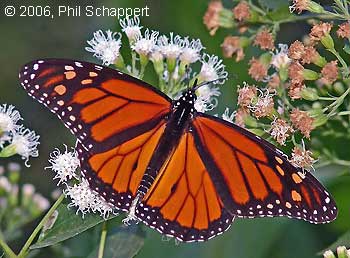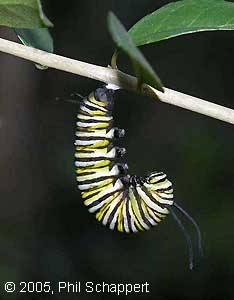 Articles...
Articles... 
Saving the King of North America
© 2004, Phil Schappert
Authors note: The article below is, essentially, an edited version of the preface of the book that followed A World for Butterflies. Monarch Butterflies: Saving the King of North America was published in 2004, again by the combination of Key Porter Books in Canada and Firefly Books in the US (although Firefly earned my ire by publishing the book under a despicably negative title, The Last Monarch Butterfly: Conserving the Monarch Butterfly in a Brave New World).
 The Monarch is an unusual butterfly by almost any measure. Imagine, if you can, an entire generation of butterflies that undertake a journey en masse covering up to 4,500 km (2,800 mi) or more—to a place they've never been—in a last-ditch effort to avoid the travails of winter. Imagine also a generation that, on the whole, lives five to seven times longer than the generation that preceded it and waits all of that time to fulfill its one and only purpose—to reproduce—only to barely begin the journey back to where they came from before the vast majority of them die.
The Monarch is an unusual butterfly by almost any measure. Imagine, if you can, an entire generation of butterflies that undertake a journey en masse covering up to 4,500 km (2,800 mi) or more—to a place they've never been—in a last-ditch effort to avoid the travails of winter. Imagine also a generation that, on the whole, lives five to seven times longer than the generation that preceded it and waits all of that time to fulfill its one and only purpose—to reproduce—only to barely begin the journey back to where they came from before the vast majority of them die.
Consider that compared to even its closest relatives, never mind butterflies in general, the Monarch has a very unusual sex life: it eagerly partakes of the chemical precursors of needed sex pheromones but rarely, if ever, uses them, preferring instead to aggressively coerce its mates rather than lure them with perfumes, overtures and courtship rituals. Imagine a single butterfly that accomplishes all of this and survives, storing potentially noxious chemicals it acquires from its milkweed host plants for its own protection, only to succumb to the predators that await it at its only safe haven.
A most unusual butterfly, indeed…
 In the book, Monarch Butterflies: Saving the King of the New World, I take you on a virtual journey through the seasons and across North America from central Mexico to Canada and then back again. We begin in the overwintering grounds of the Monarch, in a living cathedral of trees where millions upon millions of butterflies wait for spring, and then travel north by northeast with the breakup of the colonies as the butterflies move to begin recolonizing their former range.
In the book, Monarch Butterflies: Saving the King of the New World, I take you on a virtual journey through the seasons and across North America from central Mexico to Canada and then back again. We begin in the overwintering grounds of the Monarch, in a living cathedral of trees where millions upon millions of butterflies wait for spring, and then travel north by northeast with the breakup of the colonies as the butterflies move to begin recolonizing their former range.
We'll follow them as they seek out their obligate caterpillar host plants, the milkweeds, then spend some time in their breeding range with the generations that follow, shifting north and then south again with the seasons and the availability of host plants, learning how the Monarch copes with the trials and tribulations of everyday life as well as the pressures we exert on their lives. Finally, we'll follow the last generation of these butterflies as they delay their natural reproductive cycle, and journey with them, south by southwest, as they make their way back to their overwintering range.
 While a plethora of books, articles and papers have been written about Monarch butterfly migration and the need to protect this endangered phenomenon, most—if not all—of them have focused on the overwintering roost sites in Mexico and California and virtually ignore what might be going on in the breeding range. Throughout my education (as an undergraduate at Trent
University in Peterborough, conducting doctoral work at York University in Toronto and continuing well into my post-doctoral work and research at the University of Texas), I have been consistently challenged to see all sides of a problem. I continually ask myself: is the glass half empty or half full? There are always two sides to every story and the conservation of the Monarch is no exception. My purpose with this book is to tackle and grapple with the other side of the Monarch story.
While a plethora of books, articles and papers have been written about Monarch butterfly migration and the need to protect this endangered phenomenon, most—if not all—of them have focused on the overwintering roost sites in Mexico and California and virtually ignore what might be going on in the breeding range. Throughout my education (as an undergraduate at Trent
University in Peterborough, conducting doctoral work at York University in Toronto and continuing well into my post-doctoral work and research at the University of Texas), I have been consistently challenged to see all sides of a problem. I continually ask myself: is the glass half empty or half full? There are always two sides to every story and the conservation of the Monarch is no exception. My purpose with this book is to tackle and grapple with the other side of the Monarch story.
The entire eastern North American Monarch population does take refuge in only a few small areas of central Mexico. This, I think, gives entirely new meaning to the old adage about the danger of having all of one's eggs in a single basket. What worries me most, however, is that Monarchs are not secure—not by any stretch of the imagination—in their breeding range either. They are threatened in a surprising number of ways, and I will argue that those threats have a dramatic impact on just how many "eggs" are in those overwintering "baskets."
 Yes, the survival of Monarch butterflies at the winter roosts impacts the potential size of the breeding population in any given year, but the reproductive success or failure of the subsequent generations of non-migrants also has dramatic effects on the number of butterflies that make it to the winter roosts. My central thesis is that you can't save one without the other.
Yes, the survival of Monarch butterflies at the winter roosts impacts the potential size of the breeding population in any given year, but the reproductive success or failure of the subsequent generations of non-migrants also has dramatic effects on the number of butterflies that make it to the winter roosts. My central thesis is that you can't save one without the other.
Given that forewarned is forearmed, I hope that this book will open your eyes to these threats and thereby offer us a means of countering them. Lincoln Brower, acknowledged to be one of the leading Monarch researchers in the world, believes that the North American Monarch actually has a very poor chance of surviving through the next 20 years. The thought of losing this familiar but wondrous creature is sobering, to say the least. The Monarch is an amazing and unusual creature, and its phenomenal migration—amongst other things—make it absolutely unique, and, in my view, completely deserving of its royalty. While it appears to be secure and unthreatened—after all, since Monarchs can now be found in a number of places all over the world it is doubtful that they will ever truly go extinct—the Monarch is actually in far more danger here in North America than we might think.


